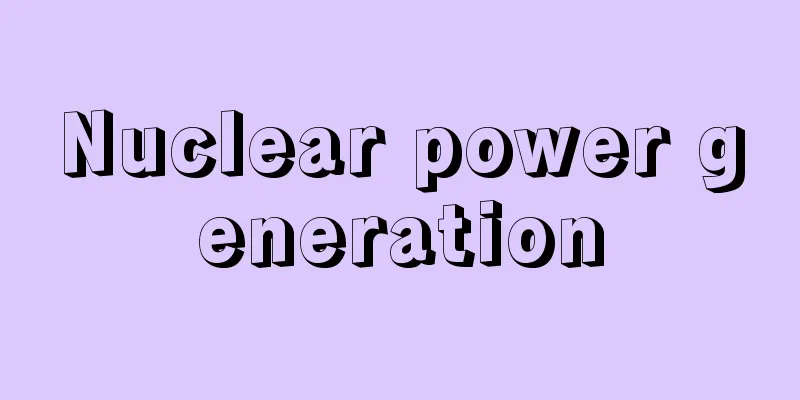Nuclear power generation

|
Nuclear fission reactions (hereafter referred to as "nuclear reactions") are caused in nuclear reactors using fissile materials such as uranium, and the energy generated is used to generate electricity. The energy generated by nuclear fission becomes heat in the reactor, and this heat is extracted in the form of steam or other fuel to drive a turbine generator. The process of generating electricity using heat is no different from thermal power generation. In other words, nuclear power plants can be considered to be constructed by replacing the boiler part of a thermal power plant with a nuclear reactor, and attaching facilities for processing radioactive materials to it. However, nuclear power generation differs from thermal power generation in that there is a possibility of a severe accident, such as a core meltdown, resulting in serious radioactive and radiation disasters. In addition, there is no established method for disposing of spent fuel or the high-level radioactive waste that is extracted by reprocessing it. Nuclear power generation has been put into practical use without overcoming two technical flaws: (1) the possibility of a severe accident occurring, and (2) the lack of established radioactive waste disposal technology. Although a large number of nuclear power plants have been built in Japan, it can be said that nuclear power generation is a technology with an extremely high risk of being put into practical use in the current technological state of the art. [Atsushi Tateno] Nuclear power reactorsThe basic components of a nuclear reactor from a functional standpoint are (1) nuclear fuel that causes nuclear fission, (2) a moderator that slows down the neutrons produced by nuclear fission to make the nuclear reaction more efficient, and (3) a coolant that cools the reactor core and also extracts the heat to be used outside. Various types of nuclear reactors can be created by combining these (fast reactors use neutrons at high speed without using a moderator, but have not yet been put to practical use due to technical difficulties). The power generation reactors currently in practical use include graphite reactors, which use graphite as a moderator, heavy water reactors, which use heavy water, and light water reactors (light water type nuclear reactors), which use light water (ordinary water) as a moderator and coolant. Light water reactors are the most widely used, accounting for 83% (number of reactors, 2006) of the world's nuclear power plants (hereafter referred to as nuclear power plants or nuclear power plants). As of 2013, all nuclear power plants in Japan are light water reactors. There are two types of light water reactors: boiling water reactors (BWRs), which generate electricity by directing steam generated in the reactor directly to a turbine, and pressurized water reactors (PWRs), which generate electricity by directing high-temperature, high-pressure primary cooling water to a heat exchanger (steam generator) where secondary water is heated and generated steam (see ). Common components of both types include the reactor core, which is filled with nuclear fuel that generates heat as a nuclear reaction occurs, the control rods that control the nuclear reaction and start and stop operation and adjust the output, the reactor pressure vessel (so named because the internal temperature is about 300°C and the pressure is high at about 160 atmospheres for PWRs and about 70 atmospheres for BWRs), and the containment vessel to contain radioactive material if the pipes or pressure vessel are damaged and it leaks. The core varies depending on the type and output of the reactor, but in a 1.1 million kilowatt class BWR, it is cylindrical with a diameter of about 4 meters and a height of 4 meters, with more than 50,000 fuel rods packed in parallel, with cooling water flowing through the gaps between them to remove heat. The fuel rods are made of uranium dioxide (ceramic) pellets packed inside a zircaloy (zirconium alloy) cladding tube with an outer diameter of about 1 centimeter and a length of about 4 meters. When the reactor is operating, heat from the nuclear reaction is generated in the core, and the temperature at the center of the pellets rises to about 2500°C, and the temperature at the surface of the cladding tube rises to about 350°C. The generation of heat continues even after the nuclear reaction is stopped by inserting the control rods, because radiation is converted into heat. This is called decay heat. When the control rods are automatically inserted (called scram) due to an earthquake or other reason and the reactor is stopped, the decay heat immediately after the operation is stopped is about 7% of that during operation, and gradually decreases thereafter, but if the cooling function to remove the decay heat is lost, the core will melt (the cause of the Fukushima Daiichi Nuclear Power Plant accident described below). The cooling water that flows through the gaps between the fuel rods has two roles: cooling the core and generating steam to generate electricity. In a BWR, the cooling water is forced to circulate by a recirculation pump and flows through the core at high speed, removing heat and turning into steam, which then passes through a steam separator at the top of the pressure vessel and heads to the turbine generator. It is called a boiling water reactor because boiling occurs inside the pressure vessel. In a PWR, the primary cooling water heated inside the pressure vessel enters the steam generator without boiling. Inside the steam generator, there are several thousand steam capillaries (outer diameter about 2 cm) made of a high-nickel alloy (Inconel), and heat is transferred through the walls of these capillaries to the secondary cooling water, generating steam and turning the turbine. The primary cooling water returns to the pressure vessel. In addition to these main cooling systems, numerous other cooling systems are installed, including an emergency core cooling system (ECCS) that injects water if the pipes are broken due to an accident and the cooling water is lost, and a residual heat removal system to remove heat when operation is stopped. The containment vessel of a BWR is only about one-quarter the volume of that of a PWR, so in the event of an accident, there is a risk that steam escaping from the pressure vessel will exceed the pressure limit and cause damage. For this reason, the steam in the containment vessel (dry well) is blown into a water-filled pressure suppression chamber (wet well) to condense and suppress the pressure rise inside the containment vessel. Although the material of the PWR containment vessel has changed from the early steel to reinforced concrete, the shape remains cylindrical and has hardly changed at all. On the other hand, in the case of BWRs, there have been many changes in shape, from flask-shaped containment vessels and torus-shaped (doughnut-shaped) pressure suppression chambers to cone-shaped containment vessels and pool-shaped pressure suppression chambers. The improved versions of BWRs and PWRs are called ABWRs and APWRs (the A stands for advanced), and efforts are being made to make them even larger, with the ABWR Kashiwazaki-Kariwa Nuclear Power Plant Unit 6 (which began operation in 1996) having an output of 1.35 million kilowatts. Construction of APWRs, Tsuruga Units 3 and 4, with an output of 1.53 million kilowatts, is currently underway. Other facilities at a nuclear power plant include the control room and other control and instrumentation facilities, turbine generators, radioactive waste treatment facilities, and spent fuel storage facilities. The control room is where the signals indicating the reactor's output, the pressure, flow rate, and temperature of the coolant, and the water level inside the reactor are all concentrated, and the reactor is controlled based on these signals. The radioactive waste treatment facility is located to treat various types of radioactive waste, such as radioactive gases generated during the operation of the nuclear power plant, cooling water leaks, washing and decontamination waste, and used ion exchange resins and filter sludge. Extremely low-level waste liquids are released into the environment, but the rest are concentrated, mixed with asphalt, and packed into drums together with solid waste and stored in a storage area (grave yard) on the site. A certain amount of "burned" fuel (25,000 to 30,000 megawatt-days/ton) is stored in a spent fuel storage pool, and then packed into special transport casks and sent to a reprocessing plant. [Atsushi Tateno] Development HistoryNuclear power generation started in the early 1950s as a result of the repurposing of military technology. The first civilian use was in the Soviet Union's graphite reactor (graphite-moderated light water-cooled reactor, Obninsk Nuclear Power Plant, started operation in 1954), followed by the UK's graphite reactor (graphite-moderated carbon dioxide-cooled reactor, Calder Hall Nuclear Power Plant, 1956). In the United States, Westinghouse modified a light water reactor (PWR) designed for nuclear submarines to build the Shippingport Nuclear Power Plant (PWR, electric output: 100,000 kilowatts) in 1956, and General Electric built the Dresden Nuclear Power Plant (BWR, electric output: 210,000 kilowatts) in 1957. However, these could not compete economically with thermal power plants, and over the next 15 years or so, there was a rapid increase in size and compactness (higher power density), resulting in the emergence of today's light water reactors. This rapid increase in size and compactness is the cause of the technical flaw of light water reactors, which is the difficulty of controlling heat in the event of an accident. In Japan, the decision to introduce the British Calder Hall reactor was made in 1957 (Showa 32), and it was built in Tokai Village, Ibaraki Prefecture, beginning operation in 1965 (ending in 1998). Around this time, American companies such as Westinghouse and General Electric made an aggressive push for light water power reactors, claiming that their safety had been "proven," and all of Japan's electric power companies, except for the Ryukyu Electric Power Public Corporation (now Okinawa Electric Power Company), and the Japan Atomic Power Company, all decided to introduce light water reactors. Thus, Japan's first light water power reactor, Tsuruga No. 1, began operation in March 1970, and Mihama No. 1 in November of the same year, and since then, nuclear power plants have been built one after another in various places. [Atsushi Tateno] Safety of Nuclear Power GenerationIn nuclear power generation, even during normal times, the safety of the total system must be considered, including not only the power plant itself, but also, for example, exposure to radiation during uranium mining, release of rare gases from reprocessing plants, and the treatment and disposal of radioactive waste. However, here we will mainly discuss issues that arise in the event of an accident at a nuclear power plant. As already mentioned, heat is generated at an extremely high density in the core of a light water reactor. For example, the core of a BWR, which is about 4.5 meters in diameter and 3.7 meters in height, generates a huge amount of heat (thermal output 3 million kilowatts), and this is cooled by 50,000 to 60,000 tons of water per hour, which is about the same flow rate as the Tama River. Therefore, if cooling is interrupted even for a short time, the core fuel temperature will rise immediately and lead to melting. The safety of nuclear power plants is important because enormous amounts of radioactivity and energy are generated inside the reactor, and even if the nuclear reaction stops, these continue to exist and pose a huge potential danger. For example, immediately after a 1.1 million kilowatt nuclear power plant is shut down after operating for a year, there is approximately 6 x 1020 becquerels of radioactivity in the reactor core. Therefore, in the event of an accident, the basic consideration of safety is how to prevent radioactivity from leaking into the environment and how to prevent residents from being exposed to radiation. In the very early stages of nuclear power development, the means of ensuring safety was to occupy a large site. However, as reactors became larger and nuclear power plants began to be built closer to cities for economic reasons, various safety devices such as emergency core cooling systems (ECCS) were added, which led to the relaxation of site standards. Meanwhile, as development progressed, various safety concepts for the design and safety review of nuclear reactors were proposed. Examples include "protection in depth," "single failure guidelines," "design basis accidents," and "low population areas." "Protection in depth" is said to consist of three barriers: (1) strict quality control to prevent failures, (2) measures to prevent failures from developing into major accidents even if they do occur (e.g. ECCS), and (3) measures to prevent the accident from spreading (containment vessels, etc.). Furthermore, the idea of evaluating "major accidents" and "virtual accidents" (also called design basis accidents) has been adopted for safety reviews. This is the idea of "assuming accidents that are technically unthinkable from a technical standpoint, and ensuring that even in such cases, the radiation exposure of people outside the site is sufficiently small" (the Fukushima Daiichi Nuclear Power Plant accident makes it clear how unrealistic these past safety review guidelines were). The main reason why the safety of nuclear power generation, which is supposed to be at least ensured by design, has been questioned and debated is because various accidents and failures have actually occurred at nuclear power plants. The causes of accidents are diverse, including equipment failure, poor design, and operational errors. Typical examples include problems caused by defects in the materials that make up the reactor, such as stress corrosion cracking of the inner walls of the pressure vessel and piping, thinning of the steam generator tubes, and damage to the fuel cladding tube due to pellet-cladding interaction. In particular, stress corrosion cracking has caused a decrease in the operation rate of the power plant in order to repair it, and since the repair work is carried out under strong radiation, it has increased the exposure of the workers (especially subcontracted workers), and has become a social problem (however, the operation rate has increased by imposing restrictions on the operation method and improving the materials). In addition, doubts have been raised about the effectiveness of the ECCS, which is supposed to play an important role in the event of an accident, as a result of a simulation experiment called the LOFT experiment conducted in the United States. [Atsushi Tateno] Occurrence of a severe accidentThe accident that occurred at Three Mile Island (TMI) in Pennsylvania, USA on March 28, 1979 literally shocked the world, as it was thought at one point that the worst case scenario of a nuclear meltdown (the China Syndrome) could have occurred, but at the same time it taught us an important lesson. The amount of radiation released into the environment as a result of the accident reached several million curies (1 curie = 3.7 x 10 10 becquerels), which is far greater than the scale of a "hypothetical accident" that is considered "technically impossible," and pregnant women and children within a five-mile radius were evacuated. The nuclear reactor was completely disabled, and the economic loss is estimated to exceed one billion dollars. The report of the Presidential Special Commission on the Accident (John G. Kemeny report) stated that "overconfidence" about safety is the most dangerous attitude, and severely criticized the government's actions, concluding that "if companies and government officials do not fundamentally change their attitude, they will be responsible for abandoning nuclear power as a useful energy source." On April 26, 1986, the Chernobyl Nuclear Power Plant, located in Ukraine, the Soviet Union, experienced the largest and most devastating nuclear accident in history, when the reactor went out of control, exploded, and 14 x 1018 becquerels of radioactive material were released into the environment. Thirty-one people lost their lives due to direct exposure to radiation and burns, and many people suffered from radiation damage, including thyroid cancer in children. At the time of the accident, 135,000 people living within a 30-kilometer radius were evacuated, but the effects of radiation extended throughout Europe, including Belarus, which was downwind. The Chernobyl Nuclear Power Plant was a graphite-moderated, light-water-cooled pressure channel reactor, which is a different type from the light-water reactors widely used today, but the accident clearly demonstrated how serious the damage can be if a major accident occurs. In nuclear power plants, where nuclear reaction energy is converted into thermal energy, accidents can occur if there is a failure to control either the nuclear reaction energy or the thermal energy. The Chernobyl accident was a reactivity accident (runaway accident) caused by a failure to control nuclear reaction energy, while the Three Mile Island accident was a loss of coolant accident (dry-fire accident) caused by a failure to control thermal energy. Both are severe accidents, defined as "accidents in which the means assumed in the safety design evaluation are unable to adequately cool the reactor core or control reactivity." These severe accidents, which were once thought to be impossible, were said to have destroyed the "safety myth." In Japan, the Tokaimura criticality accident occurred in 1999 (Heisei 11), and two workers who were exposed to large amounts of radiation subsequently died one after the other, greatly shaking public confidence in nuclear safety. In addition, the Niigata Chuetsu Offshore Earthquake of 2007 (Heisei 19) damaged the Tokyo Electric Power Company's Kashiwazaki-Kariwa Nuclear Power Plant in Niigata Prefecture, which caused a transformer fire and a small amount of radioactive material leaked into the atmosphere and sea, but did not affect the surrounding environment. After that, questions arose as to whether the surrounding faults had been properly evaluated at the time of nuclear power plant design. Then, on March 11, 2011, the Tohoku Pacific Ocean Earthquake caused an accident at the Tokyo Electric Power Company's Fukushima Daiichi Nuclear Power Plant. Of the six nuclear reactors, Units 1 to 3, which were in operation, experienced core meltdowns, and the hydrogen gas released caused the reactor buildings, including Unit 4, which had been shut down, to explode one after the other, releasing large amounts of radioactive material into the environment. TEPCO estimates that the amounts released into the atmosphere from March 12 to 31 were approximately 5x1017 becquerels of rare gases, 5x1017 becquerels of iodine-131, 1x1016 becquerels of cesium-137, and 1x1016 becquerels of cesium-134, and that the amounts released into the ocean from March 26 to September 30 were approximately 1.1x1016 becquerels of iodine- 131 , 3.6x1015 becquerels of cesium-137, and 3.5x1015 becquerels of cesium-134. Approximately 150,000 people were forced to evacuate to avoid a radioactive disaster. The molten core must continue to be cooled for over 10 years, and work is continuing by creating a huge circulation loop for cooling water, but there have been accidents such as water leaks from the ever-increasing number of contaminated water storage tanks. The mid- to long-term roadmap drawn up by TEPCO states that it will take nearly 30 years to complete the decommissioning of Units 1 to 4, including dismantling the reactors and removing the molten cores (core debris). The Fukushima Daiichi Nuclear Power Plant accident was a severe accident that went beyond the "major accidents" and "hypothetical accidents" that had been the subject of safety reviews in Japan up until that point. In Japan, the probability of a severe accident occurring was considered extremely low, so it was not subject to legal regulation, and countermeasures were left to the voluntary efforts of operators, with earthquake and tsunami countermeasures also being neglected. Despite doubts about safety due to a series of accidents and breakdowns, and criticism of the nuclear power policy without an established method for disposing of spent nuclear fuel, Japan's nuclear development has been pushed ahead with force through a system of collusion between industry, government, and academia. It is this very nature that has led to regulatory administration that is lenient toward operators, and has led to the Fukushima Daiichi Nuclear Power Plant accident. In response to criticism after the Fukushima accident, the government dissolved the Nuclear and Industrial Safety Agency, which was under the Ministry of Economy, Trade and Industry, the nuclear power promotion agency, and established the Nuclear Regulation Authority as an external bureau of the Ministry of the Environment. It also revised the existing safety review guidelines and established regulatory standards focusing on "design standards," "major accidents," and "earthquakes and tsunamis." The Nuclear Regulation Authority has established standards for "major accident countermeasures" and claims to have "taken the world's strictest severe accident countermeasures," but the possibility of operating nuclear power plants at such a huge risk, assuming that a severe accident will occur, should be questioned once again. The new regulatory standards refer to "severe accidents" as "major accidents," but this is not appropriate as it may be confused with the "major accidents" in the old safety review guidelines. [Atsushi Tateno] [References] | | | | | | | accident| | | | |©Shogakukan "> Principle of light water power reactor (Diagram) ©Shogakukan "> Schematic diagram of a pressurized water nuclear power plant ©Shogakukan "> Structure of pressurized water reactor and steam generator From the front, Units 7, 6, and 5. Kashiwazaki City, Niigata Prefecture and Kariwa Village, Kariwa District ©Shogakukan "> Kashiwazaki-Kariwa Nuclear Power Plant Source: Shogakukan Encyclopedia Nipponica About Encyclopedia Nipponica Information | Legend |
|
原子炉内でウランなど核分裂性物質を用いて核分裂反応(以下、核反応)を起こし、発生したエネルギーを利用して発電を行うこと。核分裂によって生じたエネルギーは原子炉内でいったん熱となり、この熱を蒸気などの形で取り出してタービン発電機を駆動する。熱を利用して発電する過程は火力発電と変わらない。つまり原子力発電所は、火力発電所のボイラー部分を原子炉に置き換え、これに放射性物質の処理施設などを付置することによって構成されているとみることができる。 しかし、原子力発電は、炉心溶融のようなシビアアクシデント(過酷事故)を起こして重大な放射能・放射線災害をもたらす可能性がある点で、火力発電と異なる。また、使用済み燃料やそれを再処理して取り出す高レベル放射性廃棄物の処分方法も確立していない。原子力発電は、(1)シビアアクシデント発生の可能性がある、(2)放射性廃棄物処分技術が未確立である、という二つの技術的欠陥が克服されないまま実用化が進められ、日本でも大量の発電所が建設されてきたが、現在の技術状況において実用に供するには、きわめてリスクの高い技術であるといえる。 [舘野 淳] 発電用原子炉機能から見た原子炉の基本的な構成要素は、(1)核分裂を起こす核燃料、(2)核分裂によって発生した中性子を減速して核反応の効率をよくするための減速材、(3)炉心を冷却すると同時に、その熱を外部に取り出して利用するための冷却材、の三者であり、これらの組合せによってさまざまなタイプの原子炉ができる(減速材を用いず中性子を高速のまま利用するものが高速炉であるが、技術的困難性のため実用に至っていない)。 現在実用化されている発電用原子炉には、減速材に黒鉛を用いる黒鉛炉や、重水を用いる重水炉、減速材および冷却材として軽水(普通の水)を用いる軽水炉(軽水型原子炉)がある。もっとも多く用いられているのは軽水炉で、世界の原発(以下、原子力発電炉または原子力発電所を略称して原発とよぶ)の83%(基数ベース、2006年)を占める。2013年の時点で日本にある原発はすべて軽水炉である。 軽水炉には、原子炉内で発生した蒸気を直接タービンに導き発電を行う沸騰水型炉(BWR:Boiling Water Reactor)と、高温高圧となった一次冷却水を熱交換器(蒸気発生器)に導きそこで二次系の水を加熱して発生させた蒸気で発電を行う加圧水型炉(PWR:Pressurized Water Reactor)の2種類がある(参照)。両者に共通な構成部分として、核反応が起きて熱を発生する核燃料が詰め込まれた炉心、核反応を制御して運転の開始や停止・出力の調整を行う制御棒、これらを閉じ込めている原子炉圧力容器(内部の温度は約300℃、圧力はPWRで約160気圧、BWRで約70気圧と高圧なのでこう名づけられている)、さらに、配管や圧力容器が破損して放射性物質が漏れた場合にこれを閉じ込めるための格納容器がある。 炉心は炉の形式・出力によっても異なるが、110万キロワット級BWRでほぼ直径4メートル、高さ4メートルの円柱形であり、5万本以上の燃料棒がびっしりと平行に置かれ、そのすきまを冷却水が流れ熱を除去している。燃料棒は、外径約1センチメートル、長さ約4メートルのジルカロイ(ジルコニウム合金)の被覆管内部に、二酸化ウラン(セラミック)のペレットを詰めたものである。原子炉運転中、炉心では核反応の熱が発生し、ペレット中心部の温度は2500℃、被覆管表面温度は350℃程度にまで上昇する。熱の発生は、制御棒が挿入されて核反応が停止しても、放射線が熱に変わるため継続する。これを崩壊熱とよぶ。地震などで制御棒が自動的に挿入され(スクラムとよぶ)原子炉が停止した場合、運転停止直後の崩壊熱は運転時の7%程度で、その後次第に減少するが、崩壊熱を除去する冷却機能が失われれば炉心溶融に至る(後述する福島第一原子力発電所事故の原因)。 燃料棒のすきまを流れる冷却水は、炉心の冷却と発電のための蒸気の発生との二つの役割を果たしている。運転時のBWRでは、冷却水は再循環ポンプによって強制的に循環され炉心を高速で流れ熱を奪い蒸気となり、圧力容器内上部にある気水分離機を経てタービン発電機へと向かう。沸騰水型とよばれるのは圧力容器内で沸騰が生じているためである。PWRでは、圧力容器内で熱せられた一次冷却水は沸騰せずに蒸気発生器へ入る。蒸気発生器内には、高ニッケル合金(インコネル)製の蒸気細管(外径約2センチメートル)が数千本取り付けられており、この細管壁を通じて熱が二次冷却水へ伝えられ蒸気を発生し、タービンを回す。一次冷却水は圧力容器へと戻る。なお、これらの主冷却系統に加えて、事故により配管などが破断して冷却水が失われた場合に注水を行う緊急炉心冷却装置(ECCS)や、運転停止時の熱除去のための余熱(残留熱)除去系など、数多くの冷却装置が取り付けられている。 BWRの格納容器は、PWRと比べて容積が4分の1程度と小さいため、事故の際、圧力容器から噴き出した蒸気によって耐圧限界を超え、破損するおそれがある。そのため格納容器(ドライウェル)内の蒸気を、水を張った圧力抑制室(ウェットウェル)に吹き出し凝縮させて、格納容器内の圧力上昇を抑える仕組みになっている。PWRの格納容器は初期の鋼鉄製から鉄筋コンクリート製へと材質は変化したものの、形状は円筒形でありほとんど変化していない。一方BWRの場合は、フラスコ型の格納容器とトーラス型(ドーナツ形)の圧力抑制室から、円錐形の格納容器にプール型の圧力抑制室まで、多くの形状の変遷がある。 なお、BWRとPWRの改良型は、それぞれABWR、APWRとよばれ(Aはadvancedの略)、ABWRの柏崎刈羽(かしわざきかりわ)原発6号機(1996年運転開始)で出力135万キロワットと、いっそうの大型化が図られている。APWRでは、出力153万キロワットの敦賀(つるが)3号機・4号機が建設計画中である。 原子力発電所の施設としては、このほかに、制御室を含む制御・計装施設、タービン発電機、放射性廃棄物処理施設、使用済み燃料貯蔵施設などがある。制御室には原子炉の出力を表す信号、冷却材の圧力、流量、温度、炉内水位を表す信号などが集中しており、これに基づいて原子炉の制御を行う。放射性廃棄物処理施設は、原子力発電所の運転に伴って発生する放射性のガス、冷却水の漏れや洗濯・除染廃液、さらに使用済みのイオン交換樹脂、フィルター・スラッジなど各種の放射性廃棄物を処理するために置かれている。極低レベルの廃液は環境に放出されるが、それ以外の廃液は濃縮されてアスファルトを混ぜ、固体廃棄物とともにドラム缶詰めをして敷地内の保管場所(グレーブ・ヤード)内に貯蔵される。また、一定程度(2万5000~3万メガワット・日/トン)「燃やされた」燃料は使用済み燃料貯蔵用プールに貯蔵され、その後特別な輸送用キャスクに詰められて再処理工場へと送られる。 [舘野 淳] 開発の歴史原子力発電は1950年代の初期、軍事技術の転用という形でスタートした。初めて民生用に利用されたのは旧ソ連の黒鉛炉(黒鉛減速軽水冷却型炉。オブニンスク原子力発電所、1954年運転開始)、次いでイギリスの黒鉛炉(黒鉛減速炭酸ガス冷却炉。コールダーホール発電所、1956年)であった。アメリカは原子力潜水艦用に設計された軽水炉(PWR)を改造してウェスティングハウス社が1956年シッピングポート発電所(PWR。電気出力10万キロワット)を、1957年にゼネラル・エレクトリック社がドレスデン発電所(BWR。電気出力21万キロワット)を建設した。しかしこれらは火力発電所との経済競争に打ち勝つことができず、その後15年ほどの間にきわめて急激な大型化、コンパクト化(高出力密度化)が図られ、今日の軽水炉が出現した。この急速な大型化、コンパクト化は、事故の際、熱のコントロールが困難であるという軽水炉の技術的欠陥の原因となっている。 日本においては、1957年(昭和32)イギリスのコールダーホール炉の導入が決定され、茨城県東海村に建設され、1965年運転を開始した(1998年運転終了)。このころ、ウェスティングハウス社やゼネラル・エレクトリック社などのアメリカの企業から、「安全性が実証されている」として軽水型発電炉の激しい売り込みがあり、琉球電力公社(現、沖縄電力)を除く日本の電力各社および日本原子力発電株式会社は一斉に軽水炉の導入に踏み切った。こうして1970年3月には日本初の軽水発電炉敦賀1号が、同年11月には美浜(みはま)1号が運転を開始し、これ以降各地に次々と原子力発電所が建設されてきた。 [舘野 淳] 原子力発電の安全性原子力発電においては、平常時に関しても、発電所だけではなく、たとえばウラン採鉱時における被曝や、再処理工場からの希ガスの放出、放射性廃棄物の処理処分などを含む、トータルシステムとしての安全性が考慮されなければならないが、ここではおもに原子力発電所の事故時の問題について述べる。 すでに述べたように、軽水炉の炉心では、きわめて高密度で熱が発生している。たとえば、直径約4.5メートル、高さ3.7メートルのBWRの炉心では、大量の熱が発生し(熱出力300万キロワット)、これを多摩川の流量と同程度の毎時5~6万トンの水で冷却している。したがって短時間でも冷却が途絶えると、たちまち炉心燃料温度は上昇して溶融に至る。 原子力発電所の安全性が重要視されるのは、原子炉内に莫大(ばくだい)な量の放射能およびエネルギーが発生し、たとえ核反応が停止しても、これらが引き続き存在して、巨大な潜在的危険性を形づくるからである。たとえば、110万キロワット級の原発を1年間運転し停止した直後、炉心には約6×1020ベクレルの放射能が存在する。したがって、事故が発生した場合、炉内の放射能をいかに環境に漏らさないようにするか、住民が被曝しないようにするかが、安全を考えるうえでの基本である。 原子力開発のごく初期においては、安全を保障するための手段は広い敷地をとることであった。しかし、その後、原子炉が大型化し、経済的理由から原発の都市接近が図られるようになると、緊急炉心冷却装置(ECCS)などに代表されるいろいろな安全装置が付加され、これによって立地基準の緩和が図られてきた。 一方、開発が進むにつれて、原子炉の設計や安全審査を行うための安全概念がいろいろ提起されてきた。たとえば「多重防護」「単一故障指針」「設計基準事故」「低人口地帯」などがこれである。「多重防護」とは、(1)品質管理などを厳重にして故障が起こらないようにする、(2)故障が発生してもこれを大事故に発展させないための対策(たとえばECCS)、(3)事故の拡大を防止する対策(格納容器など)、の三重の壁からなっているとされる。さらに安全審査に際しては「重大事故」、「仮想事故」(設計基準事故ともいう)を評価の対象とする考え方がとられるようになった。これは「技術的見地から起こると考えられないような事故を想定して、その際にも敷地の外側の人が受ける被曝線量は十分小さいようにする」という考え方である(こうした過去の安全審査指針がいかに現実離れしていたかは、福島第一原子力発電所事故を見れば明らかである)。 以上のように少なくとも設計上は安全性が確保されているはずの原子力発電に対して、その安全性が疑問視され、論争が行われてきた最大の理由は、現実に原子力発電所において、さまざまな事故・故障が発生してきたからであった。事故の原因は、機器の故障、設計不良、誤操作など多岐にわたっているが、その典型的な例として、圧力容器内壁や配管などの応力腐食割れ、蒸気発生器細管の減肉、ペレット被覆管相互作用による燃料被覆管の破損など、原子炉を構成している材料の欠陥に基づくトラブルをあげることができる。とくに応力腐食割れは、これを修理するために発電所の稼動率の低下をきたし、また補修作業が強放射線下で行われるために、従事する労働者(とくに下請労働者)の被曝を増大させ、社会的な問題となってきた(ただし、運転方法に制限を加えたり、材料の改善を行うことにより、稼動率は上昇した)。また事故に際して重要な役割を果たすはずのECCSについても、アメリカで行われたLOFT実験と称する模擬的な実験の結果、その有効性について疑問が提出された。 [舘野 淳] シビアアクシデントの発生1979年3月28日、アメリカ、ペンシルベニア州スリー・マイル島(TMI)で発生した事故は、炉心溶融(チャイナ・シンドローム)という最悪の事態になる可能性も一時は考えられ、文字どおり世界を震撼(しんかん)させたが、同時に重大な教訓をわれわれに与えた。事故によって環境に放出された放射能は数百万キュリー(1キュリー=3.7×1010ベクレル)に上り、これは、「技術的に起こりえない」とされている「仮想事故」の場合の規模をはるかに上回るもので、半径5マイル以内の妊婦と児童の避難が行われた。原子炉は完全に使用不能となり、経済的損失は10億ドルを上回るとされている。事故に関する大統領特別調査委員会の報告(ケメニーJohn G. Kemeny報告)は、安全であると「過信」することこそ、もっとも危険な態度であるとし、行政のあり方に厳しく批判を加え、「もし企業や行政担当者が抜本的に態度を改めないならば、彼らこそが有用なエネルギー源としての原子力を手離す責任を負うことになる」と結論づけた。 1986年4月26日、当時のソ連・ウクライナ共和国にあるチェルノブイリ原子力発電所4号炉において、原子炉の暴走により原子炉が爆発炎上し、14×1018ベクレルに及ぶ放射性物質が環境に放出されるという原子力開発史上最大最悪の事故が発生した。この事故で直接、被曝や火傷などにより31人の人命が失われ、子供の甲状腺癌(がん)を含む多くの放射線障害が発生した。事故当時周辺30キロメートル圏内の住民13万5000人が避難したが、放射能の影響は風下側にあたるベラルーシをはじめとしてヨーロッパ全土に及んだ。チェルノブイリ原子力発電所は黒鉛減速・軽水冷却圧力管チャンネル型とよばれるもので、現在広く用いられている軽水炉とは形式を異にしているが、いったん巨大事故が発生した場合いかに深刻な被害が生じるかをまざまざと見せつけられた事故であった。 核反応エネルギーを熱エネルギーに転換する原発では、核反応エネルギーと熱エネルギーいずれの制御に失敗しても事故が発生する。チェルノブイリ事故は核反応エネルギーの制御に失敗した反応度事故(暴走事故)、スリー・マイル島事故は熱エネルギーの制御に失敗した冷却材喪失事故(空焚き事故)であり、いずれも、「安全設計の評価上想定された手段では適切な炉心の冷却又は反応度の制御ができない事故」と定義されるシビアアクシデントである。これらの、かつては起こり得ないとされていたシビアアクシデントにより、「安全神話」は崩壊したといわれた。 日本においては、1999年(平成11)には東海村臨界事故が発生、大量被曝した作業員2人がその後、相次いで死亡し、その安全性に対する社会的な信頼も大きく揺らぐこととなった。また、2007年(平成19)に起きた新潟県中越沖地震で、新潟県の東京電力・柏崎刈羽原子力発電所が被災、この地震により変圧器の火災や、大気中や海中に周辺環境には影響を与えない程度の微量の放射性物質漏れが発生した。その後原発設計当時の周辺断層の評価が適切に行われていたかどうかが問題となった。 そして、2011年3月11日、東北地方太平洋沖地震の影響により、東京電力福島第一原子力発電所事故が発生した。6基ある原子炉のうち運転中の1~3号機が炉心溶融に至り、発生した水素ガスによって、停止中だった4号機を含む原子炉建屋(たてや)が次々に爆発するなどして、大量の放射性物質が環境中に放出された。東京電力は、大気中への放出量について、3月12日から31日までで希ガス約5×1017ベクレル、ヨウ素131約5×1017ベクレル、セシウム137約1×1016ベクレル、セシウム134約1×1016ベクレルと推定、海洋への放出量については、3月26日から9月30日までで、ヨウ素131約1.1×1016ベクレル、セシウム137約3.6×1015ベクレル、セシウム134約3.5×1015ベクレルと推定している。放射能災害を避けるために約15万人が避難を余儀なくされた。 溶融炉心は10年以上にわたって冷却し続けなければならず、冷却水の巨大な循環ループを作って作業が続けられているが、増え続ける汚染水貯留タンクからの漏水事故などが発生している。東京電力の作成した中長期ロードマップでは、原子炉の解体、溶融炉心(炉心デブリ)の取出しなど、1~4号機の廃止措置終了までに30年近くかかるとしている。 福島第一原子力発電所事故は、それまで日本において安全審査の対象とされてきた「重大事故」、「仮想事故」を超えるシビアアクシデントである。日本ではシビアアクシデントの発生確率はきわめて小さいとして法的な規制対象とされずに、その対策は事業者の自主的取組みに任せられ、地震津波対策もなおざりにされていた。 相次ぐ事故・故障による安全性への疑問や、使用済み核燃料の処分方法が確立しないままの原発推進政策への批判にもかかわらず、日本の原子力開発は、産官学癒着体制を形成して強引に進められてきた。こうした体質こそが、事業者に甘い規制行政を生み、福島第一原子力発電所事故へとつながったといえる。 福島事故後の批判の声を受けて、政府は原子力推進官庁である経済産業省の下にあった原子力安全・保安院を解体し、新たに環境省の外局として原子力規制委員会を発足させた。また従来の安全審査指針類を改め、「設計基準」「重大事故」「地震津波」を中心とした規制基準を定めた。原子力規制委員会は、「重大事故対策」の基準を設け、「世界一厳しいシビアアクシデント対策をとった」としているが、シビアアクシデントの発生を大前提とし、巨大なリスクを冒してまで原発を運転することの可否が改めて問われるべきであろう。なお、新規制基準では「シビアアクシデント」を「重大事故」の名称でよんでいるが、これは旧安全審査指針の「重大事故」と混同するおそれがあり、妥当とは言えない。 [舘野 淳] [参照項目] | | | | | | | | | | | | |©Shogakukan"> 軽水型発電炉の原理〔図〕 ©Shogakukan"> 加圧水型原子力発電所の模式図 ©Shogakukan"> 加圧水型原子炉と蒸気発生装置の構造 手前から、7号機、6号機、5号機。新潟県柏崎市・刈羽郡刈羽村©Shogakukan"> 柏崎刈羽原子力発電所 出典 小学館 日本大百科全書(ニッポニカ)日本大百科全書(ニッポニカ)について 情報 | 凡例 |
>>: Nuclear battery - genshiryokudenchi
Recommend
Freiburg (Switzerland) (English spelling) Freiburg
The city has a population of 33,000 (1996). It is...
Takita Choin
A magazine editor during the Meiji and Taisho per...
Retention of ownership
In a sales contract, the seller promises to reserv...
Helotium sulphurinum (English spelling) Helotium sulphurinum
…It resembles fungi of the Chamaeceae family in t...
Gushikawa [city] - Gushikawa
An old city on the central east coast of Okinawa I...
Back line - Urakei
〘 noun 〙 A type of ruled line used in printing. A ...
Catherine of Alexandria (English spelling)
A saint from Alexandria (Egypt) who is said to hav...
Axion Poplar - Axion Poplar
…Abbreviated as CEDA. It was founded in March 193...
Adam Bede
…This was the first time that she used the pen na...
Akagi oroshi - Akagi oroshi
...It is mainly said on the Pacific coast, and th...
Hansen, Lars Peter
Born: October 26, 1952. Champaign, Illinois. Ameri...
Opsonization - Opsonin action
…Most of these actions are exerted by the Fc port...
Morning Calm - Asanagi (English spelling) morning calm
This refers to the calm that occurs in coastal are...
Srinagar
The capital of the state of Jammu and Kashmir in t...
Latvia - Latvia (English spelling)
An independent country in northeastern Europe, fa...









